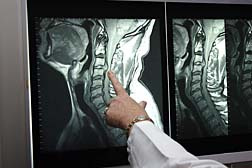Nephrogenic Systemic Fibrosis (NSF) is a painful condition that is characterized by the thickening and hardening of the skin�"mostly affecting the limbs�"but the disease can also impact internal organs and can progress so rapidly, a patient can regress from healthy to wheelchair-bound within a matter of weeks.
 Magnetic Resonance Imaging, or MRI, has evolved over the last few decades to become standard diagnostic procedure for thousands of patients. While contrasting agents are not required for MRI procedures, they aid the physician by producing a clearer and improved image. To achieve, and improve this image, the patient is injected with a contrasting agent necessary for the image to be produced.
Magnetic Resonance Imaging, or MRI, has evolved over the last few decades to become standard diagnostic procedure for thousands of patients. While contrasting agents are not required for MRI procedures, they aid the physician by producing a clearer and improved image. To achieve, and improve this image, the patient is injected with a contrasting agent necessary for the image to be produced.In normal circumstances, the kidneys do a good job of expelling the agent and ridding the body of a potentially toxic substance before it has a chance to do any damage, which as you will read can be severe. However, it has since been learned that patients with renal insufficiency cannot adequately evacuate the substance from their system.
Thus, a man-made disease has emerged that can be devastating, even life-threatening for the patient. The galling thing is that a procedure designed to aid doctors in prolonging life, may be for some shorten their lives.
Greta Carolus knows this first-hand. The registered nurse was preparing for a kidney transplant when an MRI was ordered in August of 2006. Immediately prior to the MRI procedure, Carolus was injected with a gadolinium-contrasting agent, which is normally expelled through the kidneys. However, Carolus was suffering from renal failure (hence the need for a transplant).
Four days after the MRI Carolus was hospitalized with Nephrogenic Systemic Fibrosis (NSF) and found herself in a wheelchair. "I am a registered nurse, but I have not worked since the day this happened," Carolus has said, in comments attributed to a report from ABC News 7 in Denver. "I wouldn't wish this on anybody; my worst enemy I wouldn't wish this on. This is just a terrible disease."
Researchers at Massachusetts General Hospital in Boston conducted skin examinations of 186 kidney dialysis patients. Twenty-five were found to develop skin changes consistent with NSF, and within two years 25 of the 186 patients, or 24 per cent had died. The overall death rate for patients with NSF was 48 per cent, compared with 20 per cent for patients without the illness.
The study findings were published last fall in Arthritis & Rheumatism, a medical journal, and were further explored in February of this year in the Cleveland Clinic Journal of Medicine, Volume 75, number two in the February 2nd issue.
At the heart of the issue are gadolinium-contrasting agents, of which there are five approved for use in the United States by the US Food and Drug Administration (FDA). The suspicion is that the manufacturers of the five agents may have allegedly known about the potential for disaster for patients with weak or improperly functioning kidneys, given that the gadolinium could not be properly excreted from the body.
Gadolinium is considered safe for patients with healthy kidneys, but is anything but for those with kidney issues.
"They knew how toxic it was, they may not have known the specific harm that was going to be caused but they knew the results were likely to be catastrophic," said attorney Peter Burg, in comments attributed to an ABC News 7 report. Burg is representing Carolus and several others in a lawsuit.
Carolus was injected with Omniscan, which is manufactured by General Electric Healthcare.The FDA has since requested black box warnings for all five contrasting agents, relating to the risk for developing NSF. It has been reported that patients with kidney dysfunction have a three percent risk of developing NSF following the injection of a contrasting agent, and while patients with renal failure or kidney problems stand a greater chance of acquiring NSF, recent reports suggest that even those without renal dysfunction could also be in danger from exposure to gadolinium during MRI and MRA procedures.
READ MORE LEGAL NEWS
There is little doubt that the advent of MRI and MRA procedures, and the availability of contrasting agents to improve the image, has aided diagnostics and overall, has improved the quality of life by allowing the medical community to capture evidence of an emerging problem early. However, the tragedy is that for some, an MRI is a precautionary procedure for a condition, or a suspicion that proves to be unfounded. In so doing, the patient may be exposed to a disease that could affect their quality of life, or ultimately end their life.
If you have had an MRI or MRA with a contrasting agent and have developed symptoms of NSF or NFD, you would be well advised to consult a lawyer.
